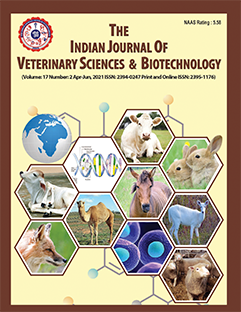Genetic Diversity and Clonal Linkages of Clostridium perfringens Type-A Isolates from Animal-Origin Foods and Human Diarrhoeal Cases using ERIC-PCR: Insights from One Health Perspective
DOI:
https://doi.org/10.48165/ijvsbt.21.6.02Keywords:
ERIC-PCR, Genetic diversity, Food-borne pathogens, One health, ZoonosesAbstract
Clostridium perfringens type A is a notable pathogen transmitted through food that causes gastroenteritis and diarrhoea in humans and animals. Gaining insight into its genetic variation and spread through the food chain is vital for public health, food safety, and the management of zoonotic diseases. This study explored the genetic connections among C. perfringens type-A isolates obtained from meat, fish, dairy products, and human diarrhoeal stool samples using Enterobacterial Repetitive Intergenic Consensus PCR (ERIC PCR), with a focus on the One health perspective. A total of 62 C. perfringens type-A isolates from meat and meat products (n=16), fish and fish products (n=19), milk and milk products (n=16), and human diarrhoeal stool samples (n=11) were analyzed using ERIC-PCR. Dendrograms were created using the UPGMA method based on the Dice similarity coefficients to evaluate the genetic diversity and potential transmission between sources. ERIC-PCR uncovered a complex genetic landscape with both clonally related and highly diverse strains across food and human isolate categories. Several clusters included isolates from both food products and human stool, indicating possible zoonotic and foodborne transmission. The discriminatory indices varied from 0.7583 (milk) to 0.8713 (fish), indicating different levels of genetic diversity among food items. The clustering patterns suggest shared contamination sources, cross-sectoral transmission routes, and the potential persistence of C. perfringens strains in food production environments, posing a significant risk to public health. This study provides molecular evidence of the genetic overlap between animal-derived food products and human diarrhoeal isolates of C. perfringens type-A, underscoring the importance of the One health approach for ensuring food safety. Integrated surveillance, improved hygiene practices, and stringent control measures across the human-animal-environment interface are crucial for reducing the risk of foodborne C. perfringens infections.
Downloads
References
Afshari, A., Jamshidi, A., Razmyar, J., & Rad, M. (2016).Genomic diversity of Clostridium perfringens strains isolated from food and human sources. Iranian Journal of Veterinary Research, 17(3), 160.
Alavandi, S.V., Ananthan, S., & Pramod, N.P. (2001).Typing of Aeromonas isolates from children with diarrhoea and water samples by randomly amplified polymorphic DNA polymerase chain reaction and whole cell protein fingerprinting. Indian Journal of Medical Research, 113, 85–97.
Anjay, A.K., Agarwal, R.K., Ramees, T.P., Dubal, Z.B., Kaushik, P., Kumar, M.S., & Bi, S. (2015).Molecular typing of Salmonella Typhimurium and S. Enteritidis serovars from diverse origin by ERIC-PCR. Journal of Pure and Applied Microbiology, 9(3), 2627–2634.
Brynestad, S., & Granum, P.E. (2002).Clostridium perfringens and foodborne infections. International Journal of Food Microbiology, 74(3), 195–202.
Deguchi, A., Miyamoto, K., Kuwahara, T., Miki, Y., Kaneko, I., Li, J., McClane, B.A., & Akimoto, S. (2009).Genetic characterization of type A enterotoxigenic Clostridium perfringens strains. PLoS One, 4(5), e5598.
Madoroba, E., Gelaw, A.K., Hlokwe, T., & Mnisi, M.S. (2010).Molecular typing of C. perfringens types among animals in South Africa. Proceedings of the 9th Annual Congress of the Southern African Society for Veterinary Epidemiology and Preventive Medicine, Farm Inn, Pretoria, South Africa, 31–35.
McClane, B.A. (1996).An overview of Clostridium perfringens enterotoxin. Toxicon, 34(11–12), 1335–1343.
Potter, N.N. (2001).Food Science. The AVI Publishing Co. Inc., New York, USA, 3.
Prescott, J.F., Parreira, V.R., Mehdizadeh G.I., Lepp, D., & Gong, J. (2016).
The pathogenesis of necrotic enteritis in chickens: what we know and what we need to know—A review. Avian Pathology, 45(3), 288–294.
Santos, G., Araiza, M., Gomez, M., & Heredia, N. (2002).
Inhibition of growth, enterotoxin production, and spore formation of Clostridium perfringens by extracts of medicinal plants. Journal of Food Protection, 65(10), 1667–1669.
Scallan, E., Hoekstra, R.M., Angulo, F.J., Tauxe, R.V., Widdowson, M.A., Roy, S.L., & Griffin, P.M. (2011).
Foodborne illness acquired in the United States—major pathogens. Emerging Infectious Diseases, 17(1), 7–15.
Szczuka, E., & Kaznowski, A. (2004).
Typing of clinical and environmental Aeromonas sp. strains by random amplified polymorphic DNA PCR, repetitive extragenic palindromic PCR, and enterobacterial repetitive intergenic consensus sequence PCR. Journal of Clinical Microbiology, 42(1), 220–228.
Talon, D., Cailleaux, V., Thouverez, M., & Michel-Briand, Y. (1996).
Discriminatory power and usefulness of pulsed-field gel electrophoresis in epidemiological studies of Pseudomonas aeruginosa. Journal of Hospital Infection, 32(2), 135–145.
Thomas, P.C., Divya, P.R., Chandrika, V., & Paulton, M.P. (2009).
Genetic characterization of Aeromonas hydrophila using protein profiling and RAPD PCR. Asian Fisheries Science, 22, 763–771.
Versalovic, J., Koeuth, T., & Lupski, R. (1991).
Distribution of repetitive DNA sequences in eubacteria and application to fingerprinting of bacterial genomes. Nucleic Acids Research, 19(24), 6823–6831.
Vinod, K.N., Sreenivasulu, D., & Reddy, Y.N. (2014).
Prevalence of Clostridium perfringens toxin genotypes in enterotoxemia-suspected sheep flocks of Andhra Pradesh. Veterinary World, 7(12), 1132–1136.
Xue-Qin, N.I., Zheng Xiao-Li, Zeng Dong, Joshua Gong, & Song Zhen-Yin. (2009).
Genetic diversity of Clostridium perfringens isolated from healthy chickens at commercial farms revealed by AFLP and ERIC-PCR. Acta Veterinaria et Zootechnica Sinica, 40(5), 717–724.
Downloads
Published
Issue
Section
License
Copyright (c) 2025 Indian Journal of Veterinary Sciences and Biotechnology

This work is licensed under a Creative Commons Attribution-NonCommercial-NoDerivatives 4.0 International License.




